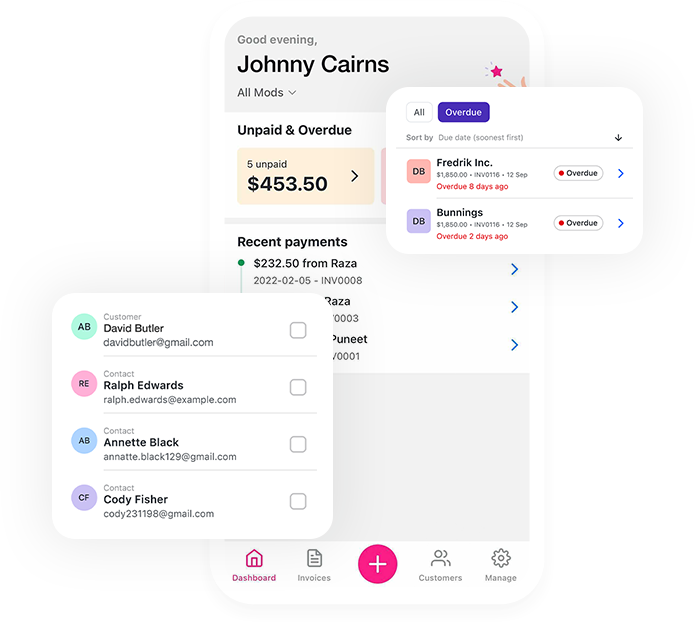Invoice on the go with the Reckon Invoices App
Start invoicing from your phone, tablet or laptop. Includes unlimited invoices.

Send invoices on the go
Create and send invoices directly from your mobile. Whether you’re on-site with a client or on the move, our user-friendly app makes it simple to generate professional invoices with just a few taps. The Reckon Invoice App has everything you need to manage invoicing quickly and easily – ensuring you get paid faster!

Create and send unlimited invoices
Send as many invoices as you need for just $11.99/month – Our invoicing software don’t base our pricing on volume! The one flat fee is perfect for small businesses and freelancers giving you peace of mind on your costs and providing an app that can scale with your business over time! You can also make an invoice simple by using the web version of the invoice app – your data syncs automatically across devices for a seamless experience.
Only $11.99/month for unlimited invoices!
Free 30-day trial. Unlimited invoices. Cancel anytime.
RECKON INVOICE APP
$11.99
Unlimited invoices
Invoices companion app
Enter & pay bills
Convert estimates to invoice
Accept credit cards & PayPal
eInvoicing enabled
Enter payments & expenses
Track GST & BAS
See cash flow in real-time
Create budgets
Accept credit card payments quickly
Getting paid has never been easier with our invoicing software. Connect the Reckon invoice app with Reckon Payments and take credit card payments directly from your Reckon invoice. Your customers can pay their invoices anywhere by simply clicking the “Pay Now” link. With more payment options, you’ll have happier customers and get paid faster, so it’s perfect for a growing small business!


Customisable invoice templates
Our invoice mobile app also includes an invoice template that lets you tailor your invoices with your logo. The invoice generator also makes it easy to customise tax rates, discounts, payment terms and due dates. You can even add your own messages and get paid with a personal touch.
Use the invoice app to keep track of overdue invoices
Easily generate invoices from your estimates saving you time and streamlining your processes with our invoicing software. Keep track of unpaid invoices on the Reckon mobile invoice app and ensure you receive prompt payment.


Add customer details and invoices on the go
On the job or on the go, the Reckon mobile invoice app helps you stay in contact with your clients. Add customer details on the fly and send your clients invoices or estimates from your mobile device by email, text, Airdrop (for apple devices) or download it as a PDF. All in one place!
Invoice app frequently asked questions
Does the Reckon Invoice App have a free trial?
Yes! Try the Reckon Invoices App for free for 30 days through the Apple App Store or Google Store. Download Reckon mobile app for invoices, register, and get started!
The Reckon Invoice App is free for current Reckon Invoices customers or $11.99/month ($5.99 for the first 3 months with current promo) for those without a Reckon One account.
How do I download the Reckon Invoices app?
Click here to download the Reckon Invoices app. Available on the Apple App Store and Google Play store.
Can I use the Reckon Invoices App on all devices?
Yes, you can manage invoices from any device including phones, tablets, or computers, providing great flexibility to fit the needs of any business owner.
What if I already have a Reckon account?
Is my data secure inside the Reckon Invoices App?
We use the best technology to ensure your data is safe and secure. Reckon One, is built with cutting-edge HTML5 technology and hosted on Australian servers powered by Amazon Web Services, a leader in cloud data storage.
Does the Reckon Invoices app have customer support?
Expert training is also available through the Reckon Training Academy or our trusted partners (accountants and bookkeepers).
What are the benefits of the Reckon Invoices App?
- Add, update, view and delete invoices
- Add and update customer and contact details
- Email invoices to customers via email or share via other apps
- Customise invoices including tax, discount, terms, classifications, service date and messages
- Create and manage invoice (product/service) items
- Review and approve invoices before sending
- Manage company settings e.g. address, ABN etc.
Download the Reckon Invoices App now for free
Includes unlimited invoices.
